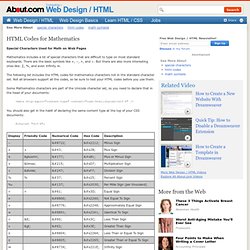

Special Characters for Mathematics - Math Symbols. Mathematics includes a lot of special characters that are difficult to type on most standard keyboards.

There are the basic symbols like +, −, ×, and ÷. But there are also more interesting ones like: ∑, %, and even infinity ∞. The following list includes the HTML codes for mathematics characters not in the standard character set. Not all browsers support all the codes, so be sure to test your HTML codes before you use them. Some Mathematics characters are part of the Unicode character set, so you need to declare that in the head of your documents: Math Characters in HTML ☀ Typesetting Mathematics Characters on the Web sans TeX/LaTeX Software♥∞ eXe. The eXe project developed a freely available Open Source authoring application to assist teachers and academics in the publishing of web content without the need to become proficient in HTML or XML markup.

Resources authored in eXe can be exported in IMS Content Package, SCORM 1.2, or IMS Common Cartridge formats or as simple self-contained web pages. eXe grew out of the New Zealand Government Tertiary Education Commission's eCollaboration Fund and was led by the University of Auckland, The Auckland University of Technology, and Tairawhiti Polytechnic. It was later supported by CORE Education, a New Zealand-based not-for-profit educational research and development organisation.
It has also been greatly assisted by a global group of participants and contributors. The History of Web Browsers [Infographic] Some infographics are better than others.
![The History of Web Browsers [Infographic]](http://cdn.pearltrees.com/s/pic/th/history-browsers-infographic-11277729)
I really like this one on the history or evolution of web broswers from TechKing. I was a big Netscape user back in the day and really disliked Microsoft’s strategy in bringing down a great browser. Microsoft’s browser share has dropped dramatically due to Firefox and Chrome. Opera has always been in the mix but never really got the due it deserved. I am still troubled by the fact that people actually use Internet Explorer as both Firefox and Chrome are superior products. Take a look: (Click to enlarge) Ultimate HTML5 Cheatsheat by Tech King Tagged as: Firefox, Google Chrome, Internet Explorer, Microsoft, Mozilla Firefox, Netscape, Opera, Web browser.
The Next Steps On The Road To Becoming A CSS Jedi Master. Last time I introduced you to the absolute beginner steps required to learning how to style websites with CSS.

Today I’d like to continue to examine some basic points, take a look at how powerful FireBug is, show you how to do CSS rollover effects, and point you in the right direction for where to go next. The Box Model One of the key concepts behind CSS is the box model that surrounds every HTML element on the page. Last time I introduced you to a fantastic utility called Firebug and the built-in Chrome equivalent. If you’ve got installed already and had a chance to play with it, you should have noticed that hovering over any element in HTML source view in the bottom left highlights a box around the element on the page view at the top.
One of the first mistakes any CSS learner will make is to confuse and use MARGIN and PADDING interchangeably. It’s also interesting to note that the border property takes up actual space and therefore affects positioning. More FireBug Magic :first-letter. 50 Truly Eye-Catching And Detailed Web Layout Tutorials. HTML and CSS Tutorials, References, and Articles. 5 Baby Steps To Learning CSS & Becoming A Kick-Ass CSS Sorcerer. This article is aimed at users who have very little experience with CSS yet, though hopefully there is something here for everyone.

Before you start playing with CSS, you may want to download our fantastic free beginner guide to XHTML. (1) Grammar Like any language, CSS has a certain grammar to it, and it may seem a little “computer programmy” at first, but it’s really just a list of things. All CSS is written like this: As you may already know, CSS works by applying a style to a selected element in the webpage. You can also use the same block of CSS to do more than one type of element at the same time with commas: This makes not only all the links, but also all the h2 and h3 headings, in the same red color. . (2) Class & ID selectors Sometimes you don’t want to style ALL the a elements in the same way though – and in those cases, you could use CLASS or ID.
<div id="sidebar"><h1>SIDEBAR</h1><div><img src=".. " alt="" class="red-rounded" /></div></div>